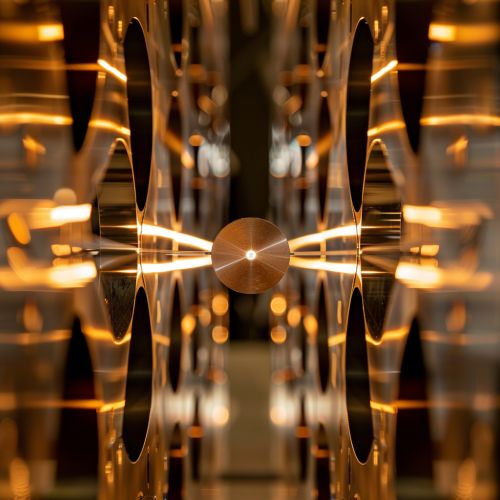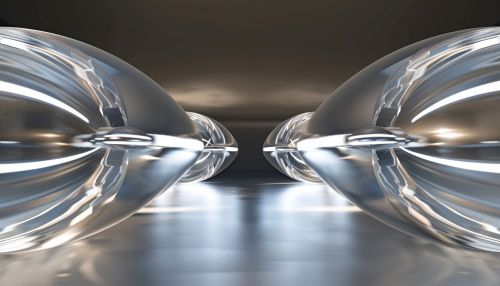Cavity (optics): Difference between revisions
(Created page with "== Introduction == A cavity in optics, also known as an optical cavity or resonator, is a structure that allows light waves to circulate and resonate within a confined space. Optical cavities are fundamental components in various optical devices, including lasers, interferometers, and optical parametric oscillators. They are designed to enhance certain properties of light, such as intensity, coherence, and spectral purity, by providing a feedback mechanism that reinforce...") |
No edit summary |
||
| Line 11: | Line 11: | ||
The choice of mirror reflectivity, spacing, and curvature is critical in determining the cavity's performance characteristics, such as its free spectral range (FSR), finesse, and mode volume. | The choice of mirror reflectivity, spacing, and curvature is critical in determining the cavity's performance characteristics, such as its free spectral range (FSR), finesse, and mode volume. | ||
[[Image:Detail-92649.jpg|thumb|center|An optical cavity with two mirrors facing each other, with light bouncing between them.|class=only_on_mobile]] | |||
[[Image:Detail-92650.jpg|thumb|center|An optical cavity with two mirrors facing each other, with light bouncing between them.|class=only_on_desktop]] | |||
== Resonance and Modes == | == Resonance and Modes == | ||
Latest revision as of 06:57, 19 June 2024
Introduction
A cavity in optics, also known as an optical cavity or resonator, is a structure that allows light waves to circulate and resonate within a confined space. Optical cavities are fundamental components in various optical devices, including lasers, interferometers, and optical parametric oscillators. They are designed to enhance certain properties of light, such as intensity, coherence, and spectral purity, by providing a feedback mechanism that reinforces specific wavelengths and modes of the electromagnetic field.
Structure and Design
Optical cavities typically consist of two or more mirrors arranged in such a way that light bounces back and forth between them. The mirrors can be flat or curved, and their arrangement determines the cavity's mode structure and stability. The most common types of optical cavities include:
- **Fabry-Pérot Cavity**: Consists of two parallel mirrors facing each other. This simple configuration is widely used in spectroscopy and laser physics.
- **Confocal Cavity**: Features two mirrors with equal radii of curvature, placed at a distance equal to their focal length. This design is stable and supports a wide range of transverse modes.
- **Ring Cavity**: Comprises three or more mirrors arranged in a closed loop, allowing light to circulate in a single direction. Ring cavities are often used in ring lasers and optical gyroscopes.
The choice of mirror reflectivity, spacing, and curvature is critical in determining the cavity's performance characteristics, such as its free spectral range (FSR), finesse, and mode volume.


Resonance and Modes
Optical cavities support specific resonant modes, which are standing wave patterns that fit perfectly within the cavity. These modes are characterized by their frequency, spatial distribution, and polarization. The resonance condition for a cavity is given by:
\[ m \lambda = 2 L \]
where \( m \) is an integer (the mode number), \( \lambda \) is the wavelength of light, and \( L \) is the cavity length. Only wavelengths that satisfy this condition will resonate within the cavity.
- Longitudinal Modes
Longitudinal modes refer to the standing wave patterns along the cavity's length. The separation between adjacent longitudinal modes is determined by the cavity's FSR, given by:
\[ \text{FSR} = \frac{c}{2L} \]
where \( c \) is the speed of light. The FSR defines the spectral spacing between resonant frequencies.
- Transverse Modes
Transverse modes describe the spatial distribution of the electromagnetic field perpendicular to the cavity axis. These modes are often classified using the Hermite-Gaussian or Laguerre-Gaussian functions. The fundamental transverse mode, denoted as TEM\(_{00}\), has a Gaussian intensity profile and is the most desirable mode for many applications due to its high beam quality.
Quality Factor and Finesse
The quality factor (Q-factor) and finesse are important parameters that describe the performance of an optical cavity. The Q-factor is a dimensionless parameter that quantifies the cavity's ability to store energy, defined as:
\[ Q = \frac{2 \pi \times \text{Stored Energy}}{\text{Energy Loss per Cycle}} \]
A high Q-factor indicates low energy loss and high resonance sharpness. Finesse, on the other hand, measures the cavity's spectral resolution and is given by:
\[ \mathcal{F} = \frac{\text{FSR}}{\Delta \nu} \]
where \( \Delta \nu \) is the linewidth of the resonant mode. High finesse implies narrow linewidths and high spectral purity.
Applications
Optical cavities are integral to numerous applications in science and technology:
- Lasers
In lasers, optical cavities provide the feedback mechanism necessary for stimulated emission and coherent light generation. The cavity enhances the gain medium's amplification by reinforcing specific wavelengths and modes, leading to the production of a highly monochromatic and coherent beam.
- Interferometry
Optical cavities are used in interferometers to measure small changes in distance, refractive index, or other physical quantities. The enhanced sensitivity and resolution provided by the cavity's resonance properties make them ideal for precision measurements in fields such as metrology and gravitational wave detection.
- Optical Parametric Oscillators
Optical parametric oscillators (OPOs) utilize optical cavities to achieve phase matching and efficient frequency conversion. The cavity enhances the nonlinear interaction between the pump, signal, and idler waves, enabling the generation of tunable coherent light across a wide spectral range.
Advanced Concepts
- Mode-Locking
Mode-locking is a technique used to generate ultrashort pulses of light by phase-locking the longitudinal modes of an optical cavity. This results in the constructive interference of modes, producing a train of pulses with durations in the femtosecond to picosecond range. Mode-locked lasers are essential tools in ultrafast optics and time-resolved spectroscopy.
- Frequency Comb Generation
Optical cavities can be used to generate optical frequency combs, which are spectra consisting of equidistant frequency lines. Frequency combs are valuable for precision spectroscopy, optical clocks, and frequency metrology. They are typically produced using mode-locked lasers or microresonators.
- Cavity Quantum Electrodynamics (CQED)
Cavity quantum electrodynamics studies the interaction between light and matter within an optical cavity at the quantum level. CQED experiments investigate phenomena such as strong coupling, quantum entanglement, and single-photon sources. These studies have implications for quantum information processing and fundamental tests of quantum mechanics.
See Also
- Laser
- Interferometer
- Optical Parametric Oscillator
- Mode-Locking
- Frequency Comb
- Cavity Quantum Electrodynamics
